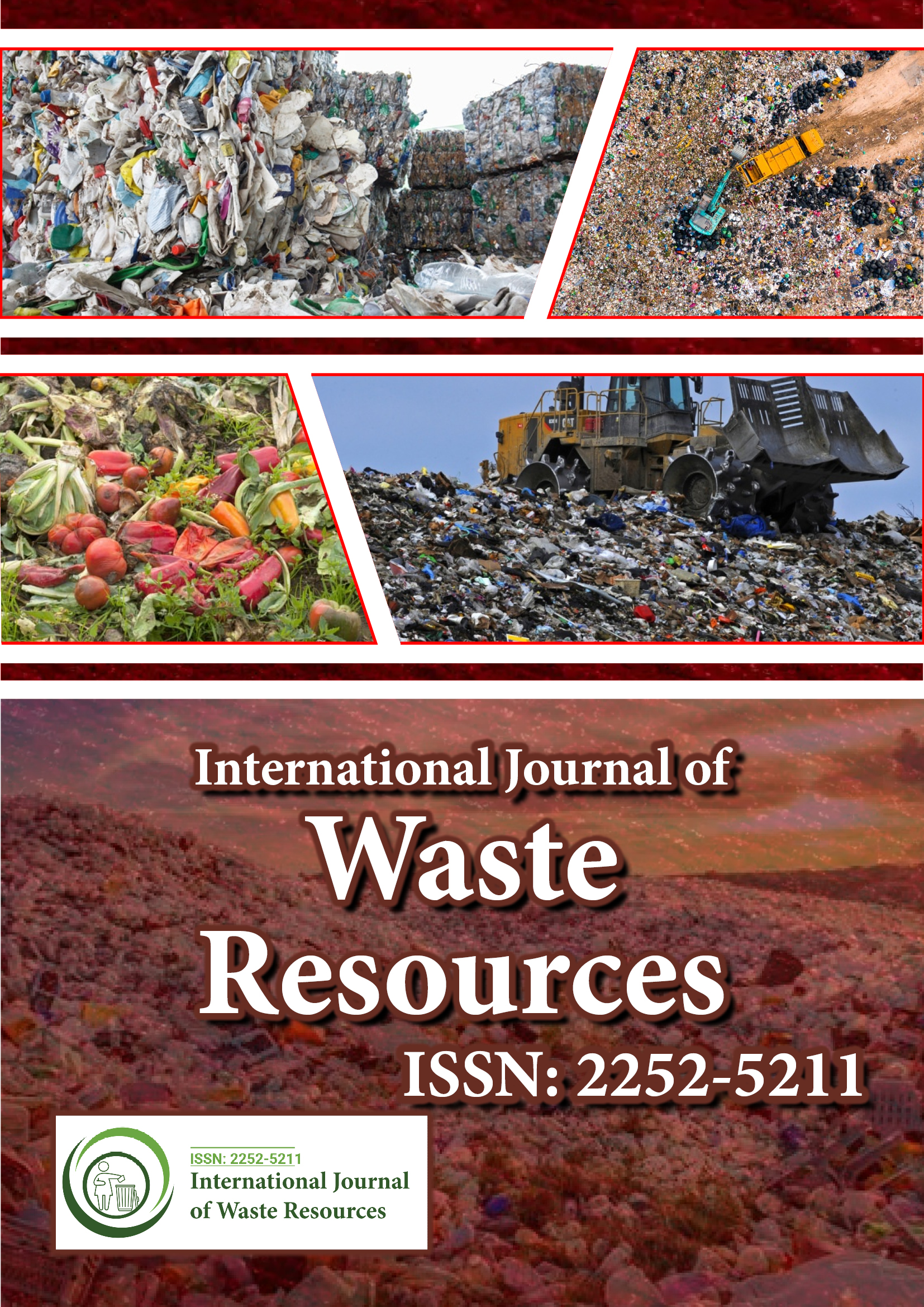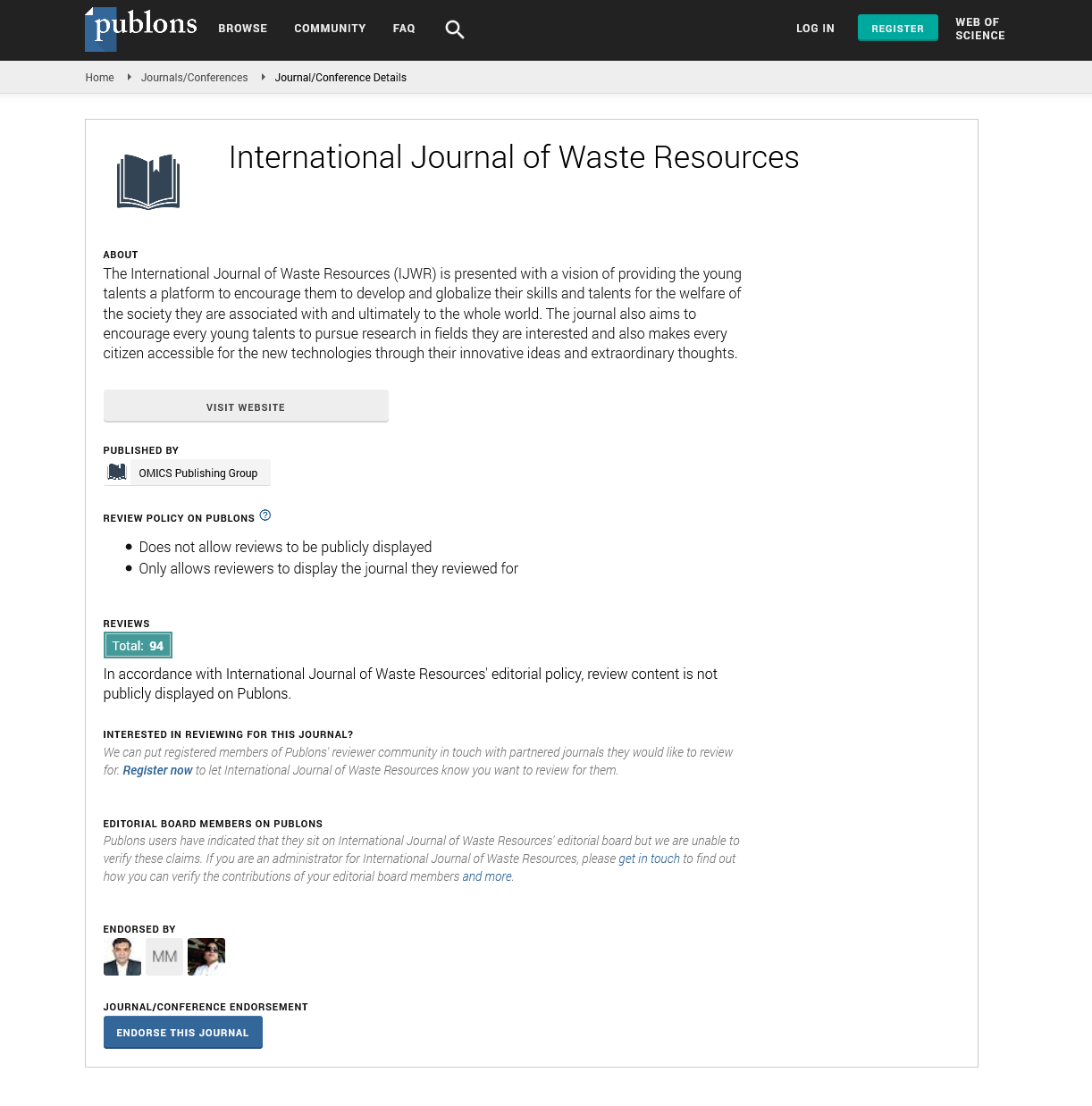Indexed In
- Open J Gate
- The Global Impact Factor (GIF)
- Open Archive Initiative
- VieSearch
- International Society of Universal Research in Sciences
- China National Knowledge Infrastructure (CNKI)
- CiteFactor
- Scimago
- Ulrich's Periodicals Directory
- Electronic Journals Library
- RefSeek
- Directory of Research Journal Indexing (DRJI)
- Hamdard University
- EBSCO A-Z
- Publons
- Google Scholar
Useful Links
Share This Page
Journal Flyer

Open Access Journals
- Agri and Aquaculture
- Biochemistry
- Bioinformatics & Systems Biology
- Business & Management
- Chemistry
- Clinical Sciences
- Engineering
- Food & Nutrition
- General Science
- Genetics & Molecular Biology
- Immunology & Microbiology
- Medical Sciences
- Neuroscience & Psychology
- Nursing & Health Care
- Pharmaceutical Sciences
Opinion Article - (2024) Volume 14, Issue 4
Addressing Challenges: Variability of Waste Streams and Microbial Engineering
Parlotte Cevans*Received: 28-Nov-2024, Manuscript No. IJWR-24-28371; Editor assigned: 02-Dec-2024, Pre QC No. IJWR-24-28371 (PQ); Reviewed: 16-Dec-2024, QC No. IJWR-24-28371; Revised: 23-Dec-2024, Manuscript No. IJWR-24-28371 (R); Published: 30-Dec-2024, DOI: 10.35248/2252-5211.24.14.596
Description
The growing environmental burden of hazardous chemical waste calls for innovative and sustainable strategies for its management. Microbial Fuel Cells (MFCs) have emerged as an innovative technology, providing the dual benefit of waste remediation and bioelectricity generation. Recent advancements in MFC designs and materials have significantly enhanced their efficiency, scalability and environmental impact, positioning them as transformative tools for eco-friendly chemical waste management.
MFCs control the metabolic activity of microorganisms to convert chemical energy in organic or inorganic waste into electrical energy. This process not only neutralizes hazardous chemicals but also generates renewable energy, providing a circular solution to waste management challenges. Optimizing the design and materials of MFCs has played a pivotal role in overcoming the limitations of traditional systems, paving the way for broader applications in industrial, medical and environmental sectors.
One of the key advancements in MFC technology lies in the engineering of electrode materials. The anode and cathode are critical components of MFCs, facilitating electron transfer during microbial metabolism. Traditional electrode materials, such as graphite or carbon cloth, often suffer from low conductivity, high costs and limited surface area for microbial attachment. Recent innovations in nanostructured materials, such as graphene, carbon nanotubes and metal-organic frameworks, have significantly improved conductivity, surface area and biocompatibility. These materials enhance the efficiency of electron transfer, allowing for higher power output and faster degradation of hazardous chemicals.
Membrane materials, which separate the anode and cathode chambers, have also seen substantial improvements. The development of Proton Exchange Membranes (PEMs) with enhanced ionic conductivity and chemical stability has minimized energy losses and improved the durability of MFCs. Advances in membrane materials, such as bio-based polymers or nanocomposites, have further reduced costs and improved sustainability, aligning MFC technology with green chemistry principles.
The design of MFC architectures has evolved to address scalability and versatility. Innovations such as stacked MFCs, tubular configurations and modular designs have enhanced the scalability of the technology, enabling its deployment in largescale waste treatment facilities. These designs allow for the efficient treatment of industrial effluents containing hazardous chemicals, including heavy metals, dyes and pharmaceuticals, which are notoriously challenging to degrade using conventional methods. Additionally, integrating MFCs with existing waste treatment infrastructure provides a practical pathway for adoption, minimizing the need for extensive retrofitting.
Despite these advancements, challenges remain in the widespread implementation of MFCs for hazardous waste management. The variability of chemical waste streams poses a significant hurdle, as certain toxic compounds can inhibit microbial activity or interfere with electron transfer processes. Research efforts are focusing on engineering robust microbial consortia capable of degrading diverse and complex pollutants. Synthetic biology approaches, such as genetically engineering bacteria to withstand toxic environments or produce specialized enzymes, hold great potential in overcoming these limitations.
Economic viability is another critical consideration. While material and design innovations have reduced costs, the initial investment for deploying MFC systems remains high compared to traditional waste treatment methods. Government incentives, public-private partnerships and continued research into costeffective materials will be essential to drive commercialization and adoption. The environmental and societal benefits of optimized MFC technology cannot be overstated. By providing an eco-friendly solution for hazardous chemical waste management, MFCs can help mitigate the risks of soil and water contamination, reduce greenhouse gas emissions and promote resource recovery. The potential to generate renewable energy from waste further underscores the transformative impact of this technology, aligning it with global sustainability goals.
In conclusion, the optimized design and material innovations in microbial fuel cells offer a transformative approach to ecofriendly hazardous chemical waste management. By addressing current challenges and leveraging interdisciplinary research, MFCs can become a foundation of sustainable waste treatment technologies. Their ability to simultaneously neutralize harmful chemicals and generate clean energy presents an unparalleled opportunity to advance environmental stewardship while meeting the energy demands of a growing population.
Citation: Cevans P (2024). Addressing Challenges: Variability of Waste Streams and Microbial Engineering. Int J Waste Resour. 14:596.
Copyright: © 2024 Cevans P. This is an open access article distributed under the terms of the Creative Commons Attribution License, which permits unrestricted use, distribution, and reproduction in any medium, provided the original author and source are credited.

